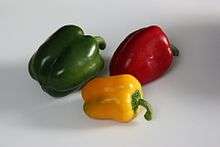Bell pepper
| Bell pepper | |
|---|---|
 Red, yellow and green bell peppers | |
| Species | Capsicum annuum |
| Heat |
|
| Scoville scale | 0 SHU |
The bell pepper (also known as sweet pepper or pepper in the United Kingdom, Canada and Ireland, and capsicum /ˈkæpsᵻkəm/[1] in Australia, India, Pakistan, Bangladesh, Singapore and New Zealand) is a cultivar group of the species Capsicum annuum.[2] Cultivars of the plant produce fruits in different colors, including red, yellow, orange, green, chocolate/brown, vanilla/white, and purple. Bell peppers are sometimes grouped with less pungent pepper varieties as "sweet peppers". The ribs and seeds inside bell peppers may be consumed, but some people find the taste to be bitter.[3]
Peppers are native to Mexico, Central America, and northern South America. Pepper seeds were imported to Spain in 1493, and from there spread to other European, African, and Asian countries. Today, China is the world's largest pepper producer, followed by Mexico and Indonesia.
Ideal growing conditions for bell peppers include warm soil, ideally 21 to 29 °C (70 to 84 °F), that is kept moist but not waterlogged.[4] Bell peppers are sensitive to an abundance of moisture and extreme temperatures.
Nomenclature
The misleading name "pepper" was given by Christopher Columbus upon bringing the plant back to Europe.[5] At that time, black pepper (peppercorns), from the unrelated plant Piper nigrum originating from India, was a highly prized condiment; the name "pepper" was at that time applied in Europe to all known spices with a hot and pungent taste and was therefore naturally extended to the newly discovered Capsicum genus. The most commonly used alternative name of the plant family, "chile", is of Mexican origin, from the Nahuatl word chilli. Botanically speaking, bell peppers are fruit, although they are considered vegetables in culinary contexts.
The bell pepper is the only member of the Capsicum genus that does not produce capsaicin,[6] a lipophilic chemical that can cause a strong burning sensation when it comes in contact with mucous membranes. The lack of capsaicin in bell peppers is due to a recessive form of a gene that eliminates capsaicin and, consequently, the "hot" taste usually associated with the rest of the Capsicum genus.[7] This recessive gene is overwritten in the Mexibelle pepper, a hybrid variety of bell pepper that produces small amounts of capsaicin (and is thus mildly pungent). Sweet pepper cultivars produce non pungent capsaicinoids,[8] with many physiological effects similar to the more pungent sister compound capsaican.[9]
The terms "bell pepper" (US), "pepper" (UK), and "capsicum" (India, Australia, and New Zealand) are often used for any of the large bell shaped fruits, regardless of their color. In British and Canadian English, the fruit is simply referred to as a "pepper", or additionally by color (as in the term "green pepper", for example), whereas in the United States and Malaysia, they are usually referred to as "bell peppers". In parts of the U.S. Midwest, bell peppers are called "mangoes."[10] Canadian English uses both "bell pepper" and "pepper" interchangeably.
In some languages, the term "paprika", which has its roots in the word for pepper, is used for both the spice and the fruit – sometimes referred to by their color (e.g., "groene paprika", "gele paprika", in Dutch, which are green and yellow, respectively). The bell pepper is called "パプリカ" (papurika) or "ピーマン" (piiman, from Portuguese pimentão) in Japan.[11] In Switzerland, the fruit is mostly called "peperone", which is the Italian name of the fruit. In France, it is called "poivron", with the same root as "poivre" (meaning "pepper") or "piment". In South Korea, the word "피망" (pimang from the Japanese "ピーマン" (piiman)) refers to green bell peppers, whereas "파프리카" (papurika from paprika) refers to bell peppers of other colors. In Sri Lanka, (only) the fruit used as a vegetable is called "maalu miris".
Colors

The most common colors of bell peppers are green, yellow, orange and red. More rarely, brown, white, lavender, and dark purple peppers can be seen, depending on the variety. Most typically, unripe fruits are green or, less commonly, pale yellow or purple. Red bell peppers are simply ripened green peppers,[12] although the Permagreen variety maintains its green color even when fully ripe. Green peppers are less sweet and slightly more bitter than yellow or orange peppers, with red bell peppers being the sweetest. The taste of ripe peppers can also vary with growing conditions and post-harvest storage treatment; the sweetest fruits are allowed to ripen fully on the plant in full sunshine, while fruit harvested green and after-ripened in storage is less sweet.
Nutritional value
| Nutritional value per 100 g (3.5 oz) | |
|---|---|
| Energy | 84 kJ (20 kcal) |
|
4.64 g | |
| Sugars | 2.4 g |
| Dietary fiber | 1.8 g |
|
0.17 g | |
|
0.86 g | |
| Vitamins | |
| Vitamin A equiv. |
(2%) 18 μg (2%) 208 μg341 μg |
| Thiamine (B1) |
(5%) 0.057 mg |
| Riboflavin (B2) |
(2%) 0.028 mg |
| Niacin (B3) |
(3%) 0.48 mg |
| Pantothenic acid (B5) |
(2%) 0.099 mg |
| Vitamin B6 |
(17%) 0.224 mg |
| Folate (B9) |
(3%) 10 μg |
| Vitamin C |
(97%) 80.4 mg |
| Vitamin E |
(2%) 0.37 mg |
| Vitamin K |
(7%) 7.4 μg |
| Minerals | |
| Calcium |
(1%) 10 mg |
| Iron |
(3%) 0.34 mg |
| Magnesium |
(3%) 10 mg |
| Manganese |
(6%) 0.122 mg |
| Phosphorus |
(3%) 20 mg |
| Potassium |
(4%) 175 mg |
| Sodium |
(0%) 3 mg |
| Zinc |
(1%) 0.13 mg |
| Other constituents | |
| Fluoride | 2 µg |
|
| |
| |
|
Percentages are roughly approximated using US recommendations for adults. Source: USDA Nutrient Database | |
Capsicum peppers are rich sources of antioxidants and vitamin C. The level of carotene, like lycopene, is nine times higher in red peppers. Red peppers have twice the vitamin C content of green peppers.[13]
Red and green bell peppers are high in para-coumaric acid.
The characteristic aroma of green peppers is caused by 3-isoButyl-2-methoxypyrazine (IBMP). Its detection threshold in water is estimated to be 2 ng/L.[14] The same chemical is responsible for characteristic Cabernet Sauvignon green note.
Production
| Country | 2004 | 2005 | 2006 | 2007 |
|---|---|---|---|---|
| |
12,031,031 | 12,530,180 | 13,031,000 | 14,033,000 |
| |
1,431,258 | 1,617,264 | 1,681,277 | 1,690,000 |
| |
1,100,514 | 1,058,023 | 1,100,000 | 1,100,000 |
| |
1,700,000 | 1,829,000 | 1,842,175 | 1,090,921 |
| |
1,077,025 | 1,063,501 | 1,074,100 | 1,065,000 |
| |
978,890 | 959,070 | 998,210 | 855,870 |
| |
720,000 | 721,000 | 721,500 | 723,000 |
| |
467,433 | 460,000 | 470,000 | 475,000 |
| |
410,281 | 395,293 | 352,966 | 345,000 |
| |
318,000 | 345,000 | 318,000 | 340,000 |
| |
237,240 | 203,751 | 279,126 | 280,000 |
| |
270,000 | 270,000 | 277,000 | 279,000 |
| |
362,430 | 362,994 | 345,152 | 252,194 |
| |
255,000 | 256,000 | 256,000 | 250,000 |
| |
265,307 | 248,614 | 275,888 | 233,000 |
| |
126,133 | 113,371 | 206,419 | 207,000 |
| |
182,340 | 190,480 | 235,570 | 192,000 |
| |
159,741 | 167,477 | 177,255 | 150,257 |
| |
153,400 | 154,000 | 146,900 | 150,000 |
| |
129,100 | 134,700 | 150,677 | 136,000 |
| World | 24,587,124 | 25,261,259 | 26,252,907 | 26,056,900 |
- Note: Serbia before 2006 included Montenegro
Gallery
-

Orange bell pepper
-

A variety of colored bell peppers
-

A whole and halved red bell pepper
-

A whole purple pepper
-

Red bell peppers
-

Japanese green pepper
-

Green, yellow and red peppers
-
_Flower.jpg)
Quadrato d'Asti Giallo bell pepper flower
-

Secondary fruit growing inside a capsicum annuum
-

Red bell pepper as decoration
-
Yellow bell pepper plant
-
Green bell pepper plant
-

Bell Pepper with Cyclamen Mite damage
See also
| Wikimedia Commons has media related to Bell pepper. |
| Wikibooks Cookbook has a recipe/module on |
References
- ↑ Wells, John C. (2008), Longman Pronunciation Dictionary (3rd ed.), Longman, p. 123, ISBN 9781405881180
- ↑ Pharmacognosy and Health Benefits of Capsicum Peppers (Bell Peppers)
- ↑ http://www.livestrong.com/article/447429-should-i-eat-a-raw-bell-pepper/
- ↑ "Growing Peppers: The Important Facts". GardenersGardening.com. Archived from the original on 27 January 2013. Retrieved 10 January 2013.
- ↑ "Medicinal Plants of the Southwest". medplant.nmsu.edu. Retrieved 2016-03-15.
- ↑ http://www.chiliwonders.com/chili.scoville.htm
- ↑ "The World's Healthiest Foods". Archived from the original on 8 February 2010. Retrieved 23 February 2010.
- ↑ Macho, Antonio; Lucena, Concepción; Sancho, Rocio; Daddario, Nives; Minassi, Alberto; Muñoz, Eduardo; Appendino, Giovanni (2003-02-01). "Non-pungent capsaicinoids from sweet pepper". European Journal of Nutrition. 42 (1): 2–9. doi:10.1007/s00394-003-0394-6. ISSN 1436-6207.
- ↑ Josse, Andrea R; Sherriffs, Scott S; Holwerda, Andrew M; Andrews, Richard; Staples, Aaron W; Phillips, Stuart M (2010-08-03). "Effects of capsinoid ingestion on energy expenditure and lipid oxidation at rest and during exercise". Nutrition & Metabolism. 7: 65. doi:10.1186/1743-7075-7-65. ISSN 1743-7075. PMC 2922296
 . PMID 20682072.
. PMID 20682072. - ↑ "Dictionary of American Regional English". Retrieved 10 October 2015.
- ↑ Azhar Ali Farooqi; B. S. Sreeramu; K. N. Srinivasappa (2005). Cultivation of Spice Crops. Universities Press. pp. 336–. ISBN 978-81-7371-521-1. Retrieved 22 August 2010.
- ↑ "Vegetable of the Month: Bell Pepper". CDC Fruit & Vegetable of the Month. Archived from the original on 3 January 2003. Retrieved 9 April 2012.
- ↑ University of the District of Columbia. "Peppers" (PDF). Center for Nutrition, Diet and Health. Retrieved 13 March 2013.
- ↑ Dominique Roujou de Boubee, School of Oenology, University of Bordeaux II. "Research on 2-methoxy-3-isoButylpyrazine in Grapes and Wine" (PDF). Retrieved 18 March 2013.
- ↑ "Table 64—World bell and chili peppers: Production 1990–2007". United States Department of Agriculture. Retrieved 2011-05-08.
